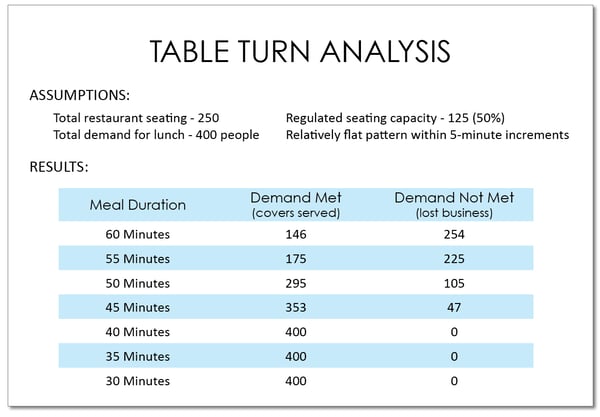#4 in the "Restaurants Post-COVID-19" series. In prior articles we’ve addressed the FOH operations regarding cleanliness and perceptions of heightened sanitation, adjusting space to allow for social distancing, and other operational issues such as paper menus and individual portions for condiments and other items that are often shared. This article is primarily designed to assist dine-in operations that have been shuttered or solely offering takeout and will be slowly re-opening.
As you open, you have to specifically look at the impact on revenue of having a “smaller” restaurant to operate. In this regard, a key issue immediately jumps to the forefront - fewer seats can translate to lower revenues, especially during peak operating times. The operations that successfully address this issue will achieve profitability and sustainability at a faster pace than the market in general.
Unlike a manufacturing environment where the pace of product production can be internally controlled, the restaurant market has peaks and valleys that can be difficult to control. There are some things that can be done to reduce the height of the peaks and spread out the business, such as:
- Early bird specials
- Incentives for early catering / take-out orders
- Off peak discounted dining
- Special fast production menus
Even with these tactics in place, operations will still be confronted with some degree of peaks and valleys, maybe not as extreme but they will be present. Dealing with these conditions while operating profitably has always been a challenge.
Managers work to address this by considering shift length or total required shifts at peak times, and adjusting service structure, such as using runners or bussers or some other hybrid model. As people begin to venture back into restaurants, volume fluctuations will initially be harder to forecast and trying to meet total customer demand will only be exacerbated by a reduction in seat capacity.
At the end of the day, the primary metric that needs to be evaluated is table turns during a meal period – especially at peak times. In looking at this metric, length of time a party sits at a table has an inverse relationship to turns. The shorter the at-table time is, the higher the turns are and therefore the higher the revenue.
In analyzing this operational need, we built a lunch period model, with the following assumptions:

What this shows is that as demand returns, a key focus needs to be on reasonably reducing a patron’s time at your table. In the past, a 50-minute meal duration would have cost the operation 105 covers which anyone can easily convert to dollars lost. At normal capacity, all of the guests, assuming a 400-cover demand would have been served. Another aspect to consider when working with this model is that many restaurants are opening at less than 50% capacity, making it even more important to focus on service style, structure and standards to be ready to take full advantage of demand as it begins to grow.
There will be various things that an operation can do to impact at-table time. Some have been discussed in relation to back of the house / kitchen operations. When turning to the direct customer facing staff, new considerations need to be given to not only the size of one’s station but more importantly the number of seated customers a server can efficiently attend to at a point in time. In our work with restaurants over many years, it is quite common to have lunch staffing parameters that use a ratio of 15 or 16 customers to one server at a point in time. In the environment facing the industry now, that ratio should probably be more like 12 to 1. And bus staff at 2.5 servers to 1 busser historically, might make more sense at 2 to 1.
These parameters are designed for peak lunch periods. Other parameters would be needed for other meal periods, which is another aspect of returning faster to profitability. Many operations account for volume in one of three ways. Breakfast, lunch, dinner operations: 3 cover counts. Lunch, dinner operations: 2 covers counts. Dinner only: 1 cover count.
Our suggestion here is to increase the number of meal periods you account for and if you are open in the afternoon between lunch and dinner, create a separate count for that 2pm to 5:30 period. For operations who are open until 11 pm or later, add a late-night cover count from 9pm to closing. While you are doing this, you may also want to use covers for bar lunch business and beverage sales as your indicator for evening bar operations.
While this probably sounds like some extra work, there is good reason to do this. First and foremost, the off-peak period between lunch and dinner can use different staffing parameters as table turns will probably not be as critical during this period. Late night business will probably follow the same pattern and will be able to use less labor for the same amount of covers over the period. Additionally, and especially for late night, the meal composition of a person eating at 10:00 pm is lighter than the peak dinner patron which converts to needing less staff in the kitchen also for an equivalent cover count. Menu abstracts, as discussed in a previous article, can be very helpful here in assessing staffing needs.
Taking full advantage of all demand opportunities will be key as business starts on the path to recovery. Anticipating demand for each meal period will be more difficult than it was historically. It is hard to project when consumer confidence will return and within some customer groups, such as seniors, how quickly their confidence will increase enough to begin dining in at restaurants. Forecasting will still be critical in helping operations plan for operations. The likelihood is that overstaffing will occur in the short run until some patterns emerge. But success will absolutely come to the businesses that shave minutes off their time-at-the-table statistics while still delivering a mistake free experience.
Read the other articles in the series:
- #1: Operating Restaurants in a COVID-19 Environment
- #2: Pre-Opening Considerations for Restaurants in a COVID-19 Environment
- #3: Menu Engineering and Planning
- #4: Taking Full Advantage of Available Demand with Post COVID-19 Restricted Restaurant Capacity
- #5: Managing the Back of the House in Post-COVID-19 Re-Opening
- #6: Operating in the New COVID-19 Normal
Know someone trying to solve their workforce management problems? Share this post them! Or, if you have questions comments, leave them below.






